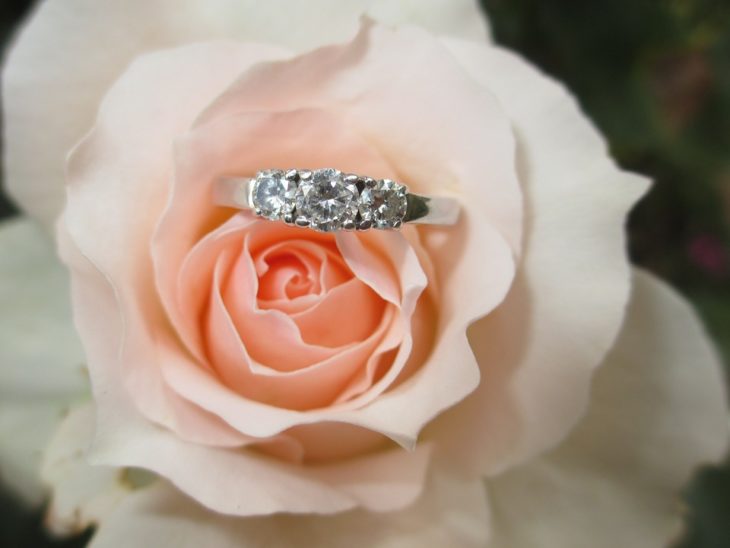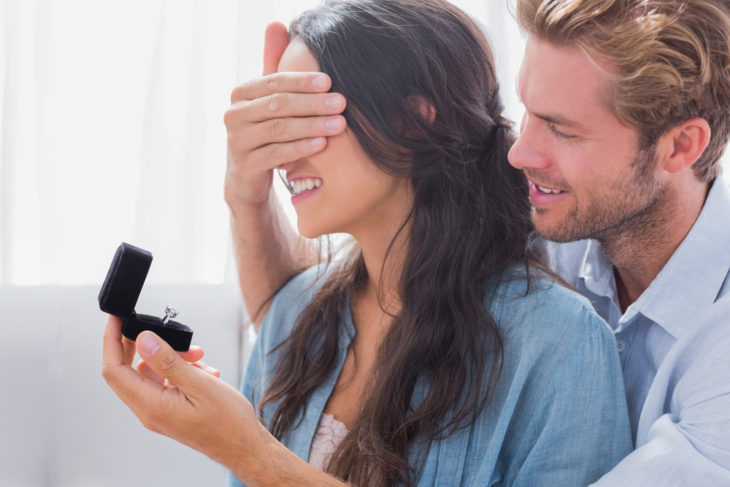I’m getting married!
Yup, my boyfriend — well, fiancé — proposed to me this weekend and of course, I said yes. Announcing it was weird, though, because while most couples take a ring selfie and post it to social media for an engagement announcement, our engagement selfie would have just kind of looked like a selfie. I told him a long time ago that I absolutely did not want a ring. Instead, we took a picture of our feet on the spot where he proposed — outside of the Museum of Contemporary Art, after Neil Gaiman (my favorite author/hero) did a reading to close out the MCA’s retrospective on David Bowie (my favorite musician/hero).
Most of my loved ones know me well enough to at least not be surprised that I didn’t want an engagement ring, but have wanted to know why. I actually hate the whole conventional proposal process because rather than feeling like it’s exciting, I feel like it ends up being unfair for everyone: the woman just keeps wondering when it’s going to happen (“it” being a life-changing commitment, the timing of which she has no control); the man feels like he’s under pressure to do something “big,” especially with all of the rather grandiose public proposals publicized in viral videos in the last few years. I’m glad that my boyfriend’s proposal was simple and special and just between the two of us, that we had pretty open communication about when approximately it was going to happen, and that every time I go to the MCA I get to be all dopey and nostalgic about it.
But on top of the whole conventional proposal process, there’s the issue of engagement rings. Let me note before I continue that I totally understand that I might be ignorant to a variety of ways that engagement rings are conceived or perceived in cultures and subcultures other than my own, as a white, middle-class woman in a monogamous male-female relationship (if not exactly “hetero”; I’m queer). But I think that a lot of my own ideas about engagement rings in the past, in my former marriage, as well as the ideas that I’ve encountered about them with other people are representative of a pretty good chunk of American men and women. And I’ve encountered plenty — my first line of work was luxury jewelry sales.
I respect it if other people happen to really love engagement rings; I’d never poo-poo a friend’s ring or tsk-tsk them for wanting one or their partner for wanting to buy one. But I do have a number of objections that might at least be worth considering:

Source: Pixabay
1. Prior to the 20th century, they didn’t exist except for the very richest people, which means that the vast majority of brides up until 1948 didn’t feel they were necessary. DeBeers popularized the concept of the diamond engagement ring with the “A Diamond Is Forever” marketing campaign only 70 years ago. [Side note: J. Courtney Sullivan’s novel The Engagements is really enjoyable and based around this whole campaign. — Amelia] I don’t know if maybe my concept of “only” is different than other people’s, of course, but since marriage has existed for millennia, 70 years doesn’t cut it for me to consider it a long-standing cultural phenomenon that you could really call a “tradition.” Here’s the kicker: DeBeer’s CEO, Nicky Oppenheimer, told the New York Times in 1999 that diamonds are worthless “except for the deep psychological need they fill.” Given that that’s the case…
2. They’re way too expensive. Median household income in America last year was $51,939. Say you take 20 percent of that for taxes, and you’re down nearer to $40,000. In 2012, the average engagement ring cost $4,000, but a study from The Knot showed something more like $5,400 in 2012 and $5,600 in 2013. So, let’s say that an engagement ring, on average, costs between 10 and 13 percent of your gross income. The average apartment costs $1,300 a month to rent, or $15,600 a year, so less the cost of housing — and that’s not utilities or food — an engagement ring is more like 16 to 23 percent of a year’s disposable income. That’s all approximate, of course (and not everyone rents, and cost of living is lower in some places and higher in others), but the point is that the expense of an engagement ring — a thing that is worthless except for the capacity in which it fills a psychological need — could be expected to take up at least a fifth and at most almost a quarter of a person’s disposable income. With the cost of living rising, that seems like an unreasonable expectation.
3. They start a marriage out inequitably. And let’s be real, here — in hetero relationships, it’s the man who’s expected to absorb that expense. Historically speaking, men have always gone to some expense for their bride, but that was a dowry, and it was basically a way of paying her family to give him legal control over her life. The difference between a dowry and an engagement ring is that a woman gets a pretty thing to adorn herself with rather than her father receiving three mules and 10 acres of land, and should the relationship dissolve after the marriage is finalized, she is entitled to half of the value of the ring (although not before the marriage is finalized). But is it really so different, at heart, if the marriage doesn’t dissolve, which I assume is always the hope?
So on the one hand, you have a situation in which a woman is basically being paid for. As in, he is buying your commitment with that ring. Looking at it a different way, you have a situation in which the woman has the privilege of not absorbing the exorbitant, extravagant, unnecessary cost of an engagement ring for her husband-to-be. Either way, that sucks. What kind of relationship dynamic does that establish? For that matter, what kind of social dynamic does that establish, or entrench? Well, one in which a man’s modus operandi is to purchase things, and a woman’s modus operandi is to be given things, especially if those things are pretty. I don’t know. My feeling is that if I want something pretty, I can buy it for myself. A partnership in which I don’t contribute proportionately — in which I don’t contribute at all — to any major expense doesn’t feel like much of a partnership, at least not by contemporary standards.

Source: AAA Jewelers
4. Men show commitment by the mere act of asking a woman to marry them. Here I’m referring to the not ubiquitous, but at least common, idea that the purpose of an engagement ring is for a man to signal his commitment to a woman by making a financial investment in their relationship. The implication there is that men can’t be taken at their word, which is part of the stereotype of men as unfaithful, as instinctual, as merely following their “primal urges” to “sow their oats” or whatever — not to mention the implication that a men only care enough about a woman or their relationships to commit if they have to put down a huge chunk of money. As in, women and relationships have no worth to men on their own, only money does, and he’s only going to care about a relationship if it means that his investment is going to be a bust. All of that is an incredibly fucked-up way to think about men, at least, again, by contemporary standards.
5. It has the stigma of marking a woman as property. There’s also the idea that is again not ubiquitous, but at least common, that women should wear engagement rings to signal to men that they’re taken. That whole concept speaks to a deep distrust in women, and although it’s the sort of thing to which plenty of men would respond, “It’s not that I don’t trust my fiancée, it’s that I don’t trust other men,” the fact is that an engaged woman without a ring is perfectly capable of rebuffing advances without an “I’m Taken!” Bat Signal on her hand. So it’s not that they don’t trust other men, it’s that they don’t trust their fiancées to rebuff advances unsupervised, which is unspeakably patronizing. If one’s fiancé believes that it’s important that she wear it to fend off other men, the message he’s looking to send is really, “I bought this person, this person is mine, back off.” And, well, that’s gross.
6. The money is better spent elsewhere. If your partner happens to have that money to spend, cool beans. But why not spend it on the relationship? Why not spend it on both of you? Why not spend it on the wedding, the honeymoon, or put it in an investment account? An equal relationship would be one in which both partners contribute what they can — money if both parties have an income, or time and effort if one doesn’t — to expenses that benefit both people. Birthdays and holidays are different — a wedding, and a marriage, is about two people and their relationship. Engagement rings are incredibly one-sided.
I’m very happy with my bare fingers — happy that I don’t have $4000 sitting on one of them, doing absolutely nothing when it could be making us memories in some beautiful locale or accruing interest somewhere. I’m also very happy with what I feel is an honest, communicative, and trusting relationship that’s going to be even and supportive for the rest of my life. We’re betting on that with the whole of our respective beings, not with the whole of our bank accounts.
Original by
